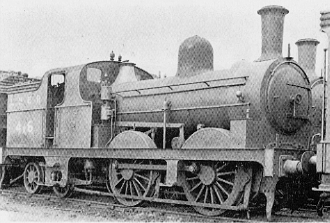The NER Fletcher G6 0-4-4T BTP Locomotives

Originally, the North Eastern Railway (NER) used its older passenger tender engines for branch line workings. In 1873 Fletcher proposed a new class of "Bogie Tank Passenger" (BTP) 0-4-4T tank locomotive for hauling passenger services on branch lines. The first batch of twelve was delivered by Neilson & Co by June 1874. These were immediately very successful and were followed by repeat orders to Hawthorn & Co. A total of 124 G6s were built, including 92 built by the NER itself.
Fletcher was known for allowing some flexibility in locomotives, and the G6s were no exception. Both manufacturers were allowed to provide many of their own detailed fittings. There were even variations in the sizes of the cylinders and the driving wheels. Nos. 28 and 188 were built with experimental steel boilers, instead of the iron boilers used on the other members of the class. Most of the G6s were eventually fitted with standard W.Worsdell steel boilers. Over time, repairs and replacements of various parts (including the boilers) tended to remove the many variations which the G6s were noted for.
The G6s were built with wooden hand brakes only. Westinghouse brakes were fitted on an experimental basis in 1879, with the remaining locomotives fitted by 1882.
The G6s continued to be used for many years, even after the Class A (LNER F8) locomotives were introduced between 1886 and 1892. Locomotives only started to become redundant with the introduction of the Class O (LNER G5) between 1894 and 1901. A total of fifty redundant G6s were rebuilt between 1899 and 1908 as Class 290 (LNER J77) 0-6-0T locomotives. In 1903, No. 957 was rebuilt as a 2-2-4T (LNER X2).
Many of the G6s became redundant with a reduction in passenger services in the later years of World War 1. This led to withdrawals starting in 1920. In 1921, ten of the idle G6s were rebuilt to create further Class 290s (LNER J77s). Withdrawals continued through the 1920s, with the last G6 withdrawn in 1929.
Technical Details
The following dimensions are the official dimensions of the G6s as they entered LNER ownership. In reality, there were some variations in cylinder size and wheel size.
| Cylinders (x2): | 17x24in. | |
| Boiler: | Diameter (max): | 4ft 3in |
| Boiler pressure: | 160psi | |
| Length: | 10ft 7in | |
| Heating Surface: | Total: | 1109 sq.ft. |
| Firebox: | 84 sq.ft. | |
| Tubes: | 1025 sq.ft. (205x 1.75") | |
| Grate Area: | 12.8 sq.ft. | |
| Wheels: | Coupled: | 5ft 6in |
| Trailing: | 3ft 4in | |
| Tractive Effort (85%): | 13,101lb | |
| Length: | 33ft 8in | |
| Total Wheelbase: | 21ft 8in | |
| Coal Capacity: | 2 tons 0cwt | |
| Water Capacity: | 1000 gallons |
Preservation
None of the G6s survived into preservation.
Models
Dave Alexander, Nu-Cast and London Road Models (ex-Stephen Barnfield) all produce 4mm scale (OO gauge) kits of the G6 0-4-4T.
Fourtrack sell a kit of the G6 (BTP) in 7mm scale (O gauge).